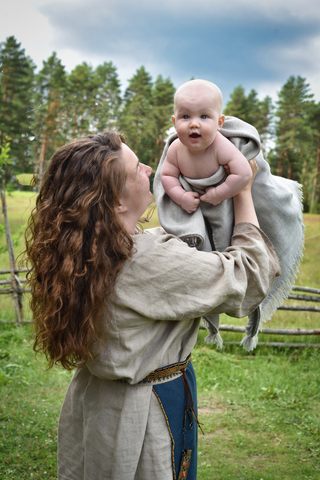
A research project launched by the Museum Centre Vapriikki has shed new light on infant feeding practices in medieval and early modern Finland. Led by PhD Tiina Väre and PhD Ulla Nordfors-a bioarchaeologist at Vapriikki and the University of Turku-the study examined early childhood diets using isotopic analysis of teeth from 13th-19th century individuals buried at the ruined St. Michael's Church in Pälkäne. The results were published in Journal of Archaeological Science: Reports
This press release features multimedia. View the full release here: https://www.businesswire.com/news/home/20250401865015/en/

According to a new study by Vapriikki, individuals who lived to adulthood in the Middle Ages received breast milk until they were over two years old. Photo: Ulla Nordfors
All studied individuals had been breastfed in infancy, but the timing of weaning differed. Individuals who survived into adulthood during the medieval period had received breast milk beyond the age of two, whereas those who died in childhood during the 18th and 19th centuries had been weaned by the age of one.
"Our sample size is small, only six individuals, because organic material rarely survives in Finland's acidic soil. Although broad generalizations cannot be made, we can still explore individual life stories," notes Ulla Nordfors.
One case involved a child who died around the age of 2.5 in the early 1800s. Isotopic values in the child's teeth indicated a decline in health before death. A notable shift in the values may suggest that breastfeeding was resumed in an attempt to treat illness, as breast milk was believed to have healing properties.
"Alternatively, the brief initial breastfeeding period followed by a return to nursing could reflect the birth of a younger sibling. Previous research has shown that the arrival of a new baby within two years increased the mortality risk for the older child," Nordfors adds.
In early 19th-century Finland, breastfeeding was increasingly supplemented with cow's milk, delivered through milk horns. These devices were difficult to clean and exposed infants to serious infections. Infant mortality remained high until the end of the 1800s.
"Interdisciplinary archaeology can bring out deeply human aspects of the past. This research gives us a rare glimpse into childcare practices and how families may have responded to children's illnesses," says Nordfors.
Research publication:
Väre, T. Nordfors, U. 2025. Early childhood diets in Medieval and Post-Medieval Pälkäne, Finland: Insights from stable isotope analysis. Journal of Archaeological Science: Reports.
https://authors.elsevier.com/sd/article/S2352-409X(25)00146-4
View source version on businesswire.com: https://www.businesswire.com/news/home/20250401865015/en/
Contacts:
Contact information:
Ulla Nordfors, ulla.nordfors@tampere.fi, +358406681312
